THE SILENCING: Killing Girls For Sport
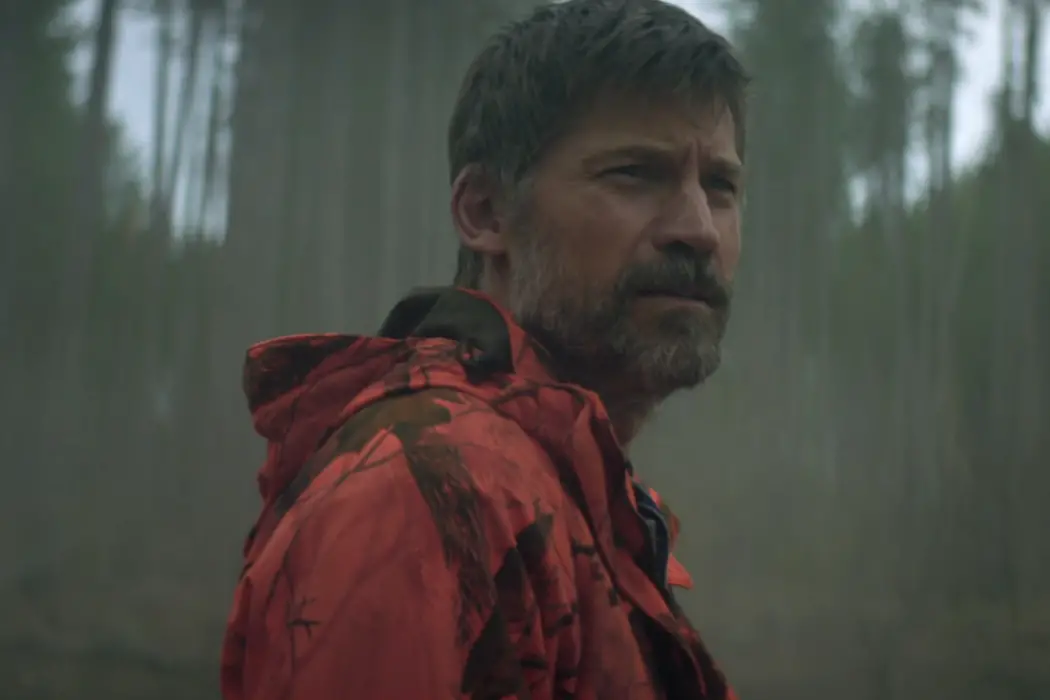
Film critic, Ithaca College and University of St Andrews graduate,…
Dead bodies washing up in lakes, lonely Minnesota forests, and grizzled hunters looking for killers in the dense, swirling fog. Tropes are tropes for a reason — it’s because they’re fun and cool as hell. And The Silencing, for the most part, knows how to use them.
The Silencing is an American thriller film from 2020 from Belgian director Robin Pront and written by writer-director Micah Ranum starring Nikolaj Coster-Waldau — not that you would’ve heard of it, since the film was released basically straight to VOD, playing in a handful of international markets and no more than 79 theaters domestically. Yet the film is a smart, lean, brooding one, which rises above its straight-to-VOD slum origins and ultimately delivers more than the sum of its parts.
Midwestern Drawls And A Serial Killer
The opening sequence of The Silencing is arresting and promising, following a body via drone as it travels down a river, eventually washing ashore at a deer reserve. Immediately, it puts you in the headspace of a good crime novel or a European thriller. The film keeps retains that verve for most of its runtime, the Belgian director and his Danish star creating a very close simulacrum of a small American town in a nondescript part of the country. (Perhaps that’s because they filmed in the forests of Canada.)
Coster-Waldau plays Rayburn Swanson, a former big-shot hunter running a sanctuary after the loss of his daughter. He’s not very conversational and is racked with guilt and self-loathing, which drives him to drink — his introductory scene finds Rayburn, noticeably drunk, intimidating a group of school children with a bear trap the way Dr. Alan Grant scares a kid with a velociraptor claw at the beginning of Jurassic Park.
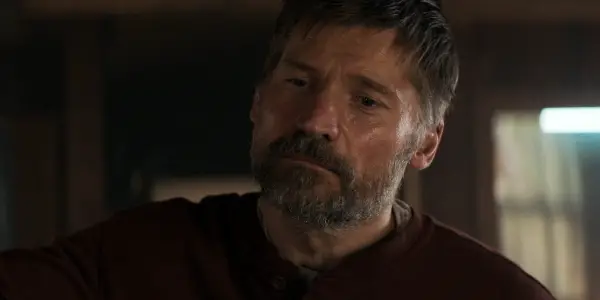
Rayburn’s a bizarre choice for the protagonist of a mystery-thriller, but he does have backup — Annabelle Wallis, recently seen obliterating a room of female prisoners in James Wan’s Malignant, is the local sheriff, and Fargo‘s Zahn McClarnon is a law enforcement officer for the local Native American reservation. The investigation into the dead girl washed ashore on Rayburn’s sanctuary grounds winds up wrapping its tendrils around all three of them, plus a small supporting cast of the local townsfolk.
The police work is nothing extraordinary — everyone seems to have seen too many true crime series, since one of the cops asks early into the investigation, “Think whoever killed her hunted her for sport?” and everyone just solemnly nods and we’re asked to accept this leap of logic to get on with the rest of the whodunit.
So yeah, the killer’s hunting young girls for sport. On Rayburn’s land. It’s hard to believe Rayburn is the culprit, so the ex-hunter sets out to find the killer for himself, and maybe find answers about the disappearance of his own little girl in the process.
Shades Of Better Movies
Pront’s direction throughout is strong, as is Ranum’s screenplay. They each do their part to rise above the VOD distribution the film has unfortunately been saddled with, not so much transcending the genre’s proliferate tropes as executing them in skillful, entertaining ways.
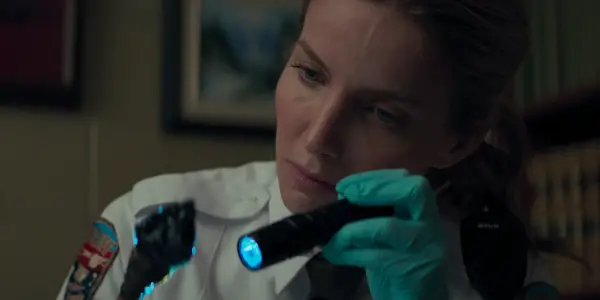
Take the serial killer story for example. Tried and true, the serial killer trope in mystery-thrillers has been done, pardon the pun, to death, with some of the best of the genre (Silence of the Lambs, Se7en, Zodiac) informing and being oft-replicated by them since. Here, a DNA swab would suggest that The Silencing has far more in common with Insomnia, the chilly early Christopher Nolan joint that finds Al Pacino traipsing through an Alaskan town and chasing Robin Williams’ elusive killer through the fog and across timber rafts. The two films’ best scenes take place in the fog, in the midst of an ominous cat-and-mouse game in the woods.
The killer in The Silencing is always seen in a gillie suit until the final reveal, playing up the character’s menace and the lonely horror of the deer sanctuary forest. The scenes of Rayburn playing hunter-prey with the killer are not only well-crafted and suspenseful, thanks to razor-sharp editing from Alain Dessauvage and Cam McLauchlin, but they also punctuate the police drama happening outside the sanctuary.
Belgian cinematographer Manuel Dacosse goes above and beyond the call of duty here, finding clever compositions and distinct, evocative lighting for each new setting. Each location — from Rayburn’s cabin to a hunting store to a club to a suspect’s basement — is very artistically designed and lit, a triumph of set design and lighting that not only makes the locations stand out, but it also provides a grimy, neon aesthetic to these scenes along the lines of Blood Simple. This has long been standard operating procedure for the best crime thrillers: If the shot looks interesting and the location stands out, the viewer is more easily drawn into the world and into the narrative.
Dacosse in particular loves his magic hour shots, as when Rayburn is coming or going from the sanctuary and often finds that his truck won’t start. Dacosse also goes full Silence of the Lambs, evoking the tight, grimy shots and frosty shadows of Tak Fujimoto for a scene where the sheriff infiltrates the home of suspect Sam Moonblood (Gregory Odjig). It’s no surprise Dacosse is so at home with these pulpy genre thrills — the DP’s been making a name for himself the last decade creating the looks of French giallo films The Strange Colour of Your Body’s Tears and Let the Corpses Tan.
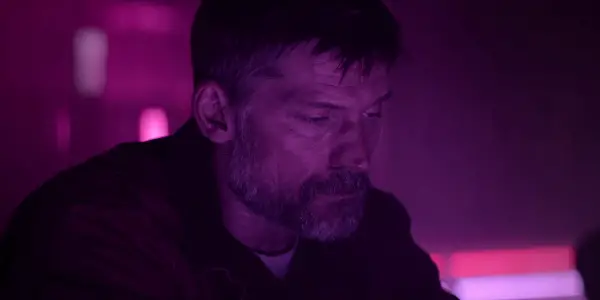
The aesthetic, combined with sturdy performances, a twisty narrative with some legitimately fun turns, and a robust team of talent in front of and behind the camera capable of executing this story with ease and aplomb, makes it a shame that The Silencing didn’t gain more acclaim upon its release. Here’s a film, clocking in at a clean 93 minutes, that has a plot like a Michael Connelly novel and dishes out its thrills at a steady pace; that’s not to say it’s perfect writing. The script, as stated, treads well-worn ground, and moment after moment from the climax onward strains credibility. But were this a miniseries instead, people would’ve eaten this up, and it would’ve had two or three seasons, easily.
Killing Teenage Girls
As for our protagonist, a whole murderers’ row of actors could’ve played the haggard ex-hunter in The Silencing. The role seems designed for Liam Neeson’s brooding complexity and old-man sternness, and the Southern drawl would seem to call for someone like Jeff Bridges or Matthew McConaughey. But Games of Thrones star Coster-Waldau stars instead as Rayburn, and though the Danish actor’s pretty-boy looks and dignified, knife’s-edge British tone don’t suit this hard-drinking, craggy old hunter loner type, you warm up to him fast. Coster-Waldau gives a commanding, anchoring performance, full of heft and grit, and coldness, that roots this murder mystery and its unlikely protagonist.
Coster-Waldau is perhaps the reason the film works so well. He’s an affable, engaging performer, and it’s nice to see Jaime Lannister get some quality material to chew on as a lead actor. Hunting for his lost daughter, Coster-Waldau’s Rayburn is all cold distance and dispassionate resolve. But Coster-Waldau also might, crucially, be the reason that the film works at all — if this were a true Southern or Midwestern U.S. actor inhabiting this role, enacting brutal vengeance against a man responsible for killing his daughter (hardly a twist, since the film treats the reveal as a foregone conclusion), then what message would that send? The Silencing would become a conservative appeal for taking justice into your own hands, feeding into the alt-right’s obsession with masculinity and libertarian dominance.
Why does the killer only target teenage girls? Narratively, it’s an easy way to symbolize some kind of deeper evil. Girls are always used as tragic victims in stories, from Red Riding Hood to slasher films. It’s a cheap, easy way for a writer to establish a villain as not just a threat morally, but a threat socially — teenage girls are often coded as symbols of promise and beauty. And those are certainly traits that The Silencing needs, with Rayburn as its depressed, drunk protagonist surrounded by a world of encroaching darkness. All fear he who preys on teenage girls.
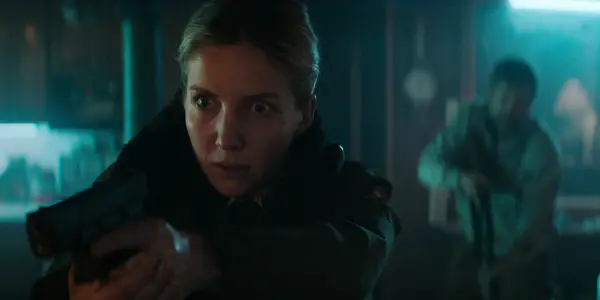
The motivation of the killer to hunt these girls is never explained, but I wish it were. There are social, political, and psychological angles to the film’s story that go undeveloped in favor of a more personal angle. I understand that the ending of Psycho — in which a psychiatrist explains to us everything wrong with Norman Bates — is bad and hokey, but at least Alfred Hitchc*ck realized that there’s something interesting under the surface of Norman worth laying bare for the audience. No such reveal in The Silencing. Was the killer a pervert? Mommy issues? Rampant misogyny? True to the fashion of Coster-Waldau’s pococurante protagonist, we never find out. The bastard’s dead; that’s all that matters to Rayburn.
The reliance on teenage girls as a plot device also ties into the film’s conservative leanings. The alt-right has long championed gender essentialism and gender roles, as well as fervent masculine superiority. Rayburn is a take on the quintessential noir hero, that breed of hard-drinking, perceptive, alternated men like Sam Spade or Philip Marlowe, the kind of not-quite anti-hero who isn’t afraid to get his hands dirty or rely on violence, to see justice done. That Rayburn is a loner living in the country with a bunch of guns and bear traps and a dog named Thor is a distinctly 21st-century American update on that archetype. Rayburn needs to be the hero and needs to come out on top — the police are incompetent and corrupt, and it’s up to the lone male savior to kill the murderer and save those girls. Casting an American actor in the part, especially someone who convincingly looks like a hermetic cabin-dweller with a broken heart, would be too much for The Silencing to bear. No, Coster-Waldau works perfectly in this film precisely because he does not completely work in the film. He is ever so slightly miscast in a way Wallis and McClarnon are not. It’s a minor, subtle calculation that saves the whole thing from a swamp of messy politics and bad taste.
Conclusion:
The Silencing is an underseen, underrated film that knows why its tropes work and stick to its guns. Its twists and turns are engaging, the performances are reliable, and it has one of the more inventive and labored patch-my-wounds-myself scenes of any movie since Revenge. The only head-scratcher here, besides a few actions in the finale that are casually brushed aside in favor of a clean resolution, is why it’s called The Silencing at all. Ignore the generic title and uninspired poster — this is a solid, satisfying mystery.
What do you think of The Silencing? Comment below and let us know.
The Silencing is now streaming on Amazon Prime.
Watch The Silencing
Does content like this matter to you?
Become a Member and support film journalism. Unlock access to all of Film Inquiry`s great articles. Join a community of like-minded readers who are passionate about cinema - get access to our private members Network, give back to independent filmmakers, and more.
Film critic, Ithaca College and University of St Andrews graduate, head of the "Paddington 2" fan club.













